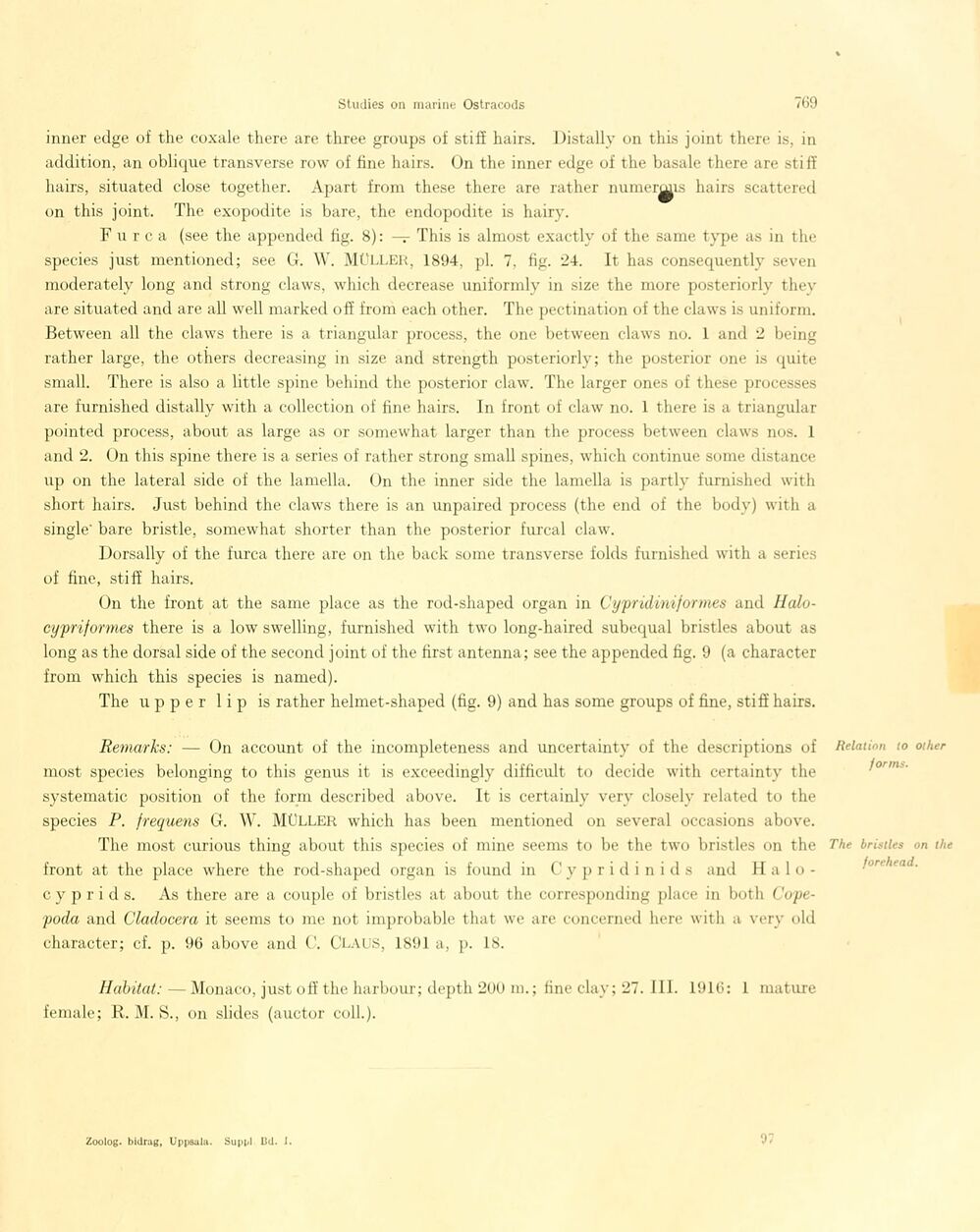
Full resolution (JPEG) - On this page / på denna sida - Sidor ...

<< prev. page << föreg. sida << >> nästa sida >> next page >>
Below is the raw OCR text
from the above scanned image.
Do you see an error? Proofread the page now!
Här nedan syns maskintolkade texten från faksimilbilden ovan.
Ser du något fel? Korrekturläs sidan nu!
This page has never been proofread. / Denna sida har aldrig korrekturlästs.
inner edge of the coxale there are three groups of stiff hairs. Distally on this joint there is, in
addition, an oblique transverse row of fine hairs. On the inner edge of the basale there are stiff’
hairs, situated close together. Apart from these there are rather numéros hairs scattered
on this joint. The exopodite is bare, the endopodite is hairy.
Furca (see the appended fig. 8): — This is almost exactly of the same type as in the
species just mentioned; see G. W. MÜLLER, 1894, pl. 7, fig. 24. It has consequently seven
moderately long and strong claws, which decrease uniformly in size the more posteriorly they
are situated and are all well marked off from each other. The pectination of the claws is uniform.
Between all the claws there is a triangulär process, the one between claws no. 1 and 2 being
rather large, the others decreasing in size and strength posteriorly; the posterior one is quite
small. There is also a little spine behind the posterior claw. The larger ones of these processes
are furnished distally with a collection of fine hairs. In front of claw no. 1 there is a triangulär
pointed process, about as large as or somewhat larger than the process between claws nos. 1
and 2. On this spine there is a series of rather strong small spines, which continue some distance
up on the lateral side of the lamella. On the inner side the lamella is partly furnished with
short hairs. Just behind the claws there is an unpaired process (the end of the body) with a
single’ bare bristle, somewhat shorter than the posterior furcal claw.
Dorsally of the furca there are on the back some transverse folds furnished with a series
of fine, stiff hairs.
On the front at the same place as the rod-shaped organ in Cypridiniformes and
Halo-cypriformes there is a low swelling, furnished with two long-haired subequal bristles about as
long as the dorsal side of the second joint of the first antenna; see the appended fig. 9 (a character
from which this species is named).
The il p p e r 1 i p is rather helmet-shaped (fig. 9) and has some groups of fine, stiff hairs.
Remarks: — On account of the incompleteness and uncertainty of the descriptions of
most species belonging to this genus it is exceedingly difficult to decide with certainty the
systematic position of the form described above. It is certainly verv elosely related to the
species P. frequens G. W. MULLER which has been mentioned on several occasions above.
The most curious thing about this species of mine seems to be the two bristles on the
front at the place where the rod-shaped organ is found in C y p r i d i n i d s and
Halo-c y p r i d s. As there are a couple of bristles at about the corresponding place in botli
Cope-poda and Cladocera it seems to me not improbable that we are concerned liere with a very old
character; cf. p. 96 above and C. CLAUS, 1891 a, p. 18.
Habitat: — Monaco, just off the harbour; depth 200 m.; fine clay; 27. III. 1916: 1 mature
female; R. M. S., on slides (auctor coll.).
Relation to other
forms.
The bristles on the
forehead.
<< prev. page << föreg. sida << >> nästa sida >> next page >>